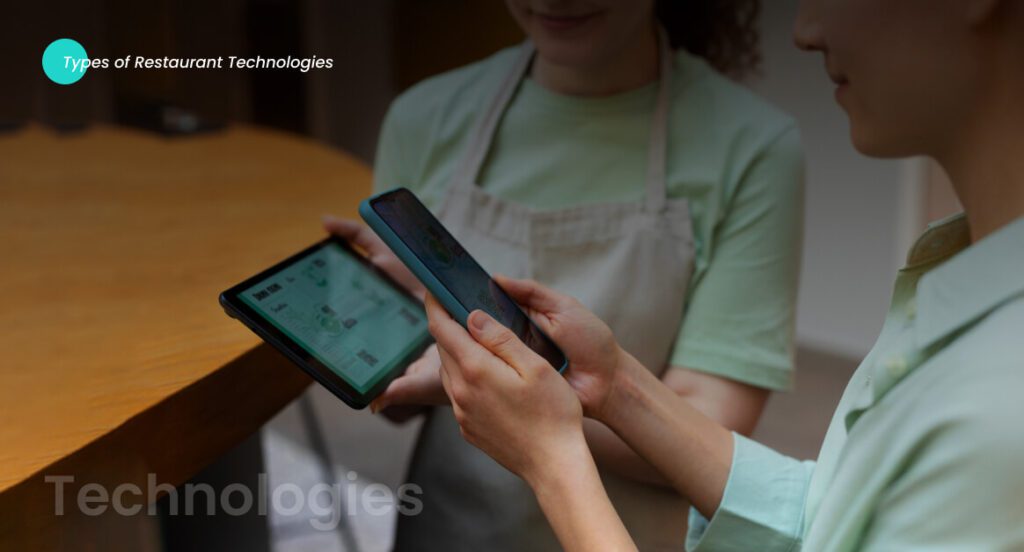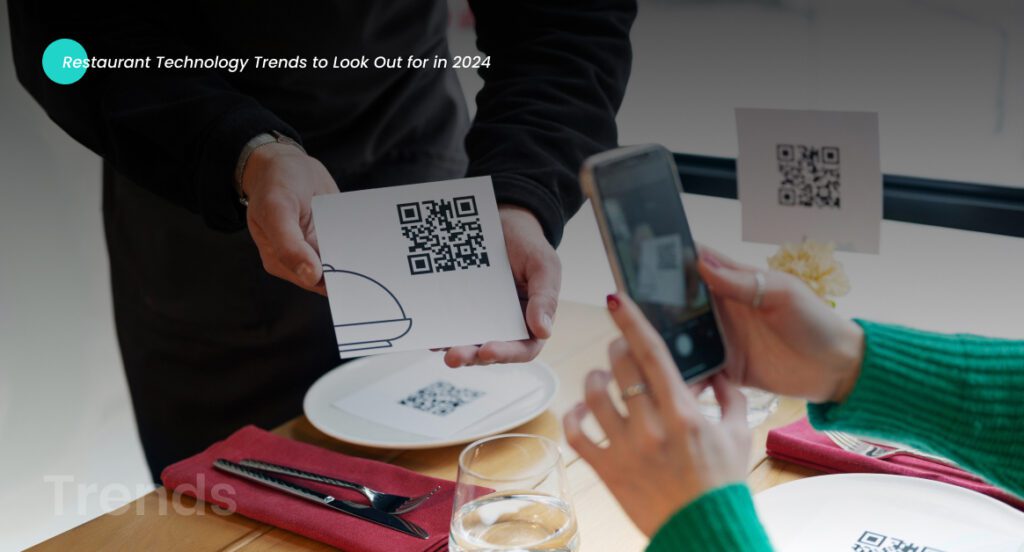Evolution in Technology for Restaurants in 2024
The restaurant industry has changed dramatically. Twenty years ago, restaurants were all about paper menus, scribbled orders on notepads, and the wait staff running frantically from the restaurant floor to the kitchen. However, the evolution of technology for restaurants has changed this dynamic drastically. What had once been all about getting a hot and tasty meal now entails an elaborate and unparalleled dining experience.
Despite this evolution, the industry still faces numerous challenges in customer satisfaction, efficiency, and changing trends. Moreover, long wait times, a lack of data-driven insights, and limited menu options have caused bottlenecks to emerge, directly impacting critical metrics like revenue and operating expenses. As an entrepreneur who already has enough on your plate, these problems can leave you spinning.
But don’t worry! The past decade has seen a rise in the adoption of technology for restaurant operationality. In this blog, we will explore the fascinating evolution of restaurant technology. These technologies enhance operational efficiency and personalize the dining experience for everyone.
How is technology changing the restaurant industry?
Technology in the restaurant has truly been revolutionized. Businesses need to adapt to new challenges to ensure smooth operationality. If you want your restaurant business to be successful in today’s industry, you will have to adapt to changes proficiently. Here’s how restaurants have grown over the years:
- Technology has streamlined the online ordering process. Self-service kiosks and mobile apps offer convenience and contactless dining.
- Loyalty programs with targeted rewards, AI-powered recommendations, and digital menus offer customization options, leading to a more personalized experience.
- Traceability features and eco-friendly packaging options get you positive word of mouth and reinforce a consumer’s interest in responsible sourcing and environmental impact.
3 Benefits of Technology for Restaurants

Technology is a major player in the restaurant industry. It offers a world of benefits for both businesses and customers. Here are some advantages:
1. Efficiency
Automating your kitchen tasks allows one of your restaurant’s most essential parts to run smoothly and efficiently. Automated kitchen tasks linked with point-of-sale systems will enable you to expedite food and beverage ordering and reduce waste. Cooking the appropriate amount of food is a crucial part of reducing waste.
Bin management technology for restaurants automates hot hold, ensuring that hot food is held for the shortest possible time. This decreases the probability of food being discarded due to being on hold for an extended period of time. Kitchen automation software allows cooks to see what has to be cooked and when dishes are needed.

2. Enhanced Customer Service
Customer ordering functions that are enabled by technology include:
- Online ordering
- Kiosk stations
- Digital signage
- Tablets on the table
- Better customer service
Kitchen automation software also provides your diners with a more enjoyable dining experience because they won’t be interrupted by the staff shouting at the chef. Automation technology helps to time meals so that everyone in a group gets served at the same time and there are no delays. Special requirements are also recorded in the customer relationship management system, so customers always get exactly what they’ve ordered.

3. Decision-Making
Data provides a wealth of insights to optimize menus, target marketing efforts, and ultimately drive business success. POS systems capture real-time information about every transaction, including sales figures, order frequency, popular dishes, and customer profiles. Analyzing which customers order which dishes helps you make better decisions for business operationality.

8 Types of Restaurant Technologies

Restaurants are increasingly utilizing digital solutions to meet customer expectations, and this trend appears to continue and even accelerate in the near future. In this section, we will discuss some of the trendiest restaurant technologies.
1. Point of Sale Systems
Modern point-of-sale (POS) technology, such as touchscreen terminals, exists to improve efficiency. They should be able to withstand the rigors of the restaurant with tough hardware and keep you and your crew moving at restaurant speed.
Most touchscreen terminals are driven by restaurant POS software with an intuitive, easy-to-use interface. This allows employees to move rapidly and new hires to learn quickly. Touchscreen POS terminals also make the ordering process easier, allowing you to place more orders faster and generate more income.
2. Self-Order Kiosks
Self-order kiosks allow restaurants to meet diner expectations, provide an optimized digital experience, and offer an easy-to-use interface. They give guests a lot more control over the entire ordering process and make it easier for them to customize their orders to their preferences. A kiosk also increases average check size and order volumes, shortens lines, and helps you deal with productivity constraints.
3. Kitchen Display Screens (KDS)
The restaurant kitchen can be stressful. Therefore, printed tickets may not be the ideal option based on your restaurant’s demands. Many restaurants are now adopting kitchen display systems (KDS) to ensure smooth functionality. KDS is more environmentally friendly than traditional ticket printers because it is completely digital. It also saves restaurants money on the modest but significant expense of ticket paper and removes the all-too-common problem of paper tickets becoming soiled with grease or dropping to the ground.
Kitchen display systems allow kitchen personnel to see all open orders on a single screen. This makes it easier for the kitchen to stay organized and fulfill orders precisely and on schedule while also keeping things running according to plan at the front of the house.
4. Printers for Restaurant
Printers are another vital technology for restaurants. Although paper receipts can be a hassle at times, they are essential for optimizing staff performance. However, to print paper receipts, you will require a thermal printer.
Thermal printers are most typically utilized in the front of the house since they print silently and quickly compared to classic impact printers. All receipt printers are thermal printers, which means they do not require ink. Instead, they heat the paper to print characters and images on thermally sensitive paper.
The most frequent type of kitchen printer is the inkjet printer. If your back-of-house personnel is swamped, they may not notice a fresh slip appear in the printer. Impact printers help avoid situations like these by using a louder printing method that attracts the attention of cooks and chefs.
5. Cash Drawer
Despite developments in POS technology, the traditional cash drawer remains powerful and crucial for keeping and managing cash. If you want a more current way to manage your restaurant’s cash drawer, integrate it with your POS system so that all transactions can be tracked. Naturally, you should lock your cash drawer overnight and empty it on a frequent basis to increase security.
6. Integrated Online Ordering Solutions
An integrated online ordering solution allows your customers to order directly from your restaurant for takeaway or contactless delivery. Furthermore, by employing an integrated online ordering system, you avoid third-party delivery fees and get greater control over the visitor experience.
The advantages of an integrated online ordering solution speak for themselves. However, some customers prefer to place online orders directly with restaurants. According to The Guide to the Restaurant Guest During COVID-19, 82% of customers order directly from a restaurant’s app or website at least once a month.
7. Order and Pay at the Table
Order and Pay at the Table is another popular restaurant technology trend that allows guests to order and pay for their meals using their own devices. This not only provides your guests with peace of mind, but it also helps you increase table turn times, lower labor costs, and gain a deeper understanding of your guests through useful data.
8. Contactless Payments
Contactless payment options are becoming increasingly significant for guests’ eating experiences. They ensure your guests’ safety and security by allowing them to pay for their orders with a tap, dip, or swipe. This eliminates unnecessary or undesired physical contact between visitors and workers.
With contactless payments, guests can tap to pay for their orders through their smartphones or contactless credit cards. These payments are always protected end-to-end with encryption and tokenization.
p class=”btn-talk relative transition”> See our latest relevant exploration Estimating Restaurant App Development CostTop Restaurant Technology Trends

Now that you have a basic understanding of restaurant technology let’s dive a little deeper and discuss the top trends that you should look out for in 2024.
Customers want a dining experience that truly stands out. With the recent advancements in technology for restaurants, there are many tools and devices to ensure an optimal diner experience both in the short and long run. Here, we will discuss a few popular trends for optimizing customer experience:
1. Online Reservations Management
As discussed in the last section, online reservations, and table management are the easiest ways of reducing wait times and leaving customers and partners satisfied. This helps reduce wait times and offers contactless payments and digital receipts – minimizing physical contact.
2. Digital Menus
Personalized digital menus address diners’ unique preferences and dietary constraints. Most restaurants’ digital menus today have all the information you need about the ingredients, allowing your customers to enjoy their meals without fear of any adverse reactions.
3. AR and VR Technology
Customers can now enjoy a new level of service by combining augmented reality (AR) and virtual reality (VR) elements. They can browse virtual menus, visualize their meals, and even explore interactive dining spaces, making their eating experience at your restaurant memorable.
4. Inventory Management – AI
With the advancement in AI, kitchen automation extends beyond customer service. Enrolling in NLP—Natural Language Processing, inventory management, and supply chain optimization can help streamline your kitchen operations. Moreover, using recent data, AI in Kitchen Automation can help you optimize inventory levels and forecast demand patterns. It will help restaurants reduce waste and increase their net profit.
5. IoT Integration
Emerging IoT integration is essential for improving kitchen efficiency. IoT integration allows you to connect with other devices seamlessly, thus reducing cooking times and enhancing energy consumption.
6. Efficient Communication Systems
Communication is essential for a well-functioning kitchen, so efficient communication systems for both front-of-house operations are critical. Digital platforms and mobile devices allow for real-time communication among employees, eliminating misunderstandings and delays.
7. Data-Driven Insights
Data can now more efficiently drive sales in the dining and service industries. Big data analytics may provide restaurants with important information about client preferences and behavior. By analyzing information from these resources, businesses can make informed decisions about the future.
- Customer Reviews
- Social Media Platforms
- Loyalty Programs
- Dining Experiences
- Tailor Menus
- Tailored Marketing Campaigns
8. Demand Forecasting
Predictive analytics is another valuable tool for restaurants. It allows businesses to estimate demand and optimize menu options. Restaurants can estimate client preferences and change their menus based on historical data, seasonal trends, and external influences. This not only lowers waste but also ensures that popular items are always in stock, resulting in enhanced consumer satisfaction and income.
9. Integrated CRM Systems
If you integrate a CRM system into your business, you can strengthen your client relationships. It helps you track consumer preferences and dining patterns. It also helps you make personalized recommendations, rewards, and promotions, promoting loyalty and driving repeat business.
10. Performance Monitoring Tools
Take it a step further by integrating your resource management system to provide more realistic and processed data that will provide valuable insights into performance measures, allowing you to identify areas for improvement and make data-driven growth decisions.
11. VR Training Modules
VR training modules offer immersive learning experiences, allowing employees to practice different scenarios and enhance their abilities in a secure and regulated setting. E-learning platforms and gamification approaches make training programs more interesting and interactive, resulting in increased employee participation and information retention.
12. Restructuring Workplace Operations and Feedback
You may design an exclusive mobile app for your employees to help with scheduling and work management. Employees can quickly check their calendars, request time off, and receive real-time changes, increasing productivity and encouraging a good work-life balance. Performance tracking and feedback systems provide continual review and improvement, allowing personnel to advance and give excellent service.
Frequently Asked Questions (FAQs)
Businesses are now using automation to streamline kitchen operations, ensure proper delivery, label food FIFOs, track food temperature and hold times, and create digital menus to optimize user experience.
Trending technologies in the restaurant industry include POS kiosks, online ordering apps and portals, and computerized maintenance systems.
The use of AI in the restaurant industry reduces human error to a great extent. AI-powered platforms process orders accurately and prevent guests from receiving the wrong dish. It also reduces wait times and optimizes the overall dining experience.
Masifa is a Content Specialist with a bachelor’s degree in marketing and over three years of experience in content marketing and the IT industry. She is passionate about writing and talking about website and mobile app development, e-commerce, and advancements happening in the IT Industry. She creates engaging and user-centric content to optimize digital experiences for these niches. When she is not creating content, you can find her buried in a good book.